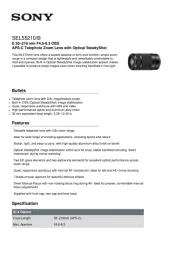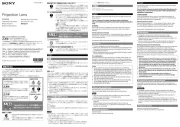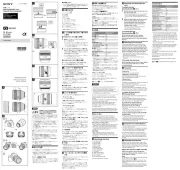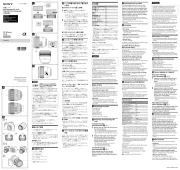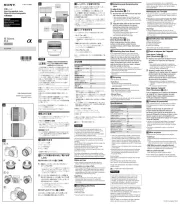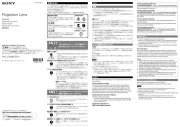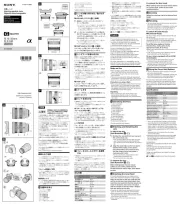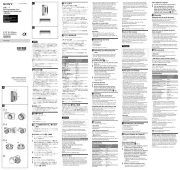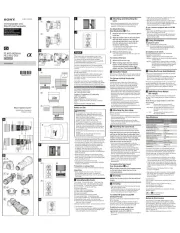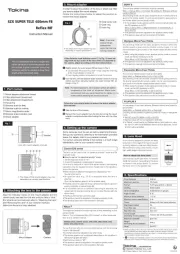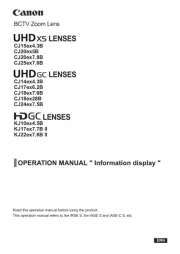
レンズフードを正確に取り付けてください。レンズフー
ドの効果が出なかったり、画面の一部にレンズフードが
撮影後レンズフードを収納するときは、逆向きにレンズ
最短撮影距離とは、撮像素子面から被写体までの距離を
このレンズは距離エンコーダーを搭載しています。距離
レンズの機構によっては、撮影距離の変化に伴って焦点
距離が変化する場合があります。記載の焦点距離は撮影
This instruction manual explains how to use lenses.
Precautions common to all lenses such as notes on use
are found in the separate “Precautions before using”. Be
sure to read both documents before using the lens.
This lens is designed for A-mount, which can be used on
Sony α cameras (models equipped with APS-C sized image
sensor). You cannot use on 35 mm-format cameras.
When carrying a camera with the lens attached, always firmly ˎ
hold both the camera and the lens.
Do not hold by any part of the lens that protrudes when ˎ
When using this lens with an E-mount camera, attach a ˎ
separately sold Mount Adaptor. Do not attach the lens directly
to the E-mount camera or you may damage both.
Precautions for flash use
When using a built-in camera flash, always remove the lens ˎ
hood and shoot at least 1m (3.3 feet) away from your subject.
With certain combinations of lens and flash, the lens may
partially block the light of the flash, resulting in a shadow at
the bottom of the picture.
When a built-in camera flash is used, the corners of the screen ˎ
may appear darker at wide-angle position. Check the focal
length according to the built-in flash on your camera.
When using lens, the corners of the screen become darker
than the center. To reduce this phenomena (called vignetting),
close the aperture by 1 to 2 stops.
1...Zooming ring 2...Zoom lock switch 3...Focusing ring
4...Lens contacts 5...Lens hood index
6...Focal-length scale 7...Focal-length index
8...Focus-mode switch 9...Mounting index
Attaching and detaching the lens
1 Remove the rear and front lens caps and the
You can attach/detach the front lens cap in two ways, (1)
and (2). When you attach/detach the lens cap with the lens
hood attached, use method (2).
2 Align the orange index on the lens barrel with
the orange index on the camera (mounting
index), then insert the lens into the camera
mount and rotate it clockwise until it locks.
Do not press the lens release button on the camera when ˎ
Do not mount the lens at an angle. ˎ
While holding down the lens release button on the
camera, rotate the lens counterclockwise until it stops,
It is recommended that you use a lens hood to reduce flare
and ensure maximum image quality.
Align the red line on the lens hood with the red line
on the lens (Lens hood index), then insert the lens
hood into the lens mount and rotate it clockwise until
the red point on the lens hood is aligned with the red
line on the lens and the lens hood clicks into place.
Attach the lens hood precisely or it may be ineffective or ˎ
When storing, fit the lens hood onto the lens backwards. ˎ
/
Interchangeable Lens/
Objectif interchangeable/
/Operating Instructions/Mode d'emploi/
Manual de instrucciones/
この取扱説明書には、事故を防ぐための重要な注意事項と製品
の取り扱いかたを示しています。この取扱説明書をよくお読
みの上、製品を安全にお使いください。お読みになったあとは、
レンズを取り付けてカメラを持ち運ぶときは、カメラと
ズームにより繰り出されたレンズ部分でカメラを保持し
マウントカメラでお使いの場合は、別売のマウントアダ
プターをご使用ください。破損のおそれがありますので、
カメラ内蔵フラッシュ使用時には、レンズフードをはず
カメラの内蔵フラッシュ使用時には、ワイド側で周辺が
お使いのカメラの内蔵フラッシュの対応焦点距離をご確
レンズは原理的に画面周辺部の光量が中心部に比べ低下
します。周辺光量の低下が気になる場合は、開放絞りか
Rotate the zooming ring to the desired focal length.
This prevents the lens barrel from extending due to the
weight of the lens while it is carried.
Slide the zoom lock switch to lock. (See illustration - .)
To unlock, slide the zoom lock switch back.
To switch between AF (auto focus) and
Focusing can be switched between AF and MF on the lens.
For AF photography, both the camera and lens should be
set to AF. For MF photography, either or both the camera
or lens should be set to MF.
To set the focus mode on the lens
Slide the focus-mode switch to the appropriate mode, AF or
MF. (See illustration - .)
To use a camera equipped with an AF/
Press the AF/MF control button to switch AF to MF when ˎ
both the camera and lens are set to AF.
Press the AF/MF control button to switch MF to AF when the ˎ
camera is set to MF and the lens is set to AF.
Direct manual focus (DMF)
Rotate the focusing ring to set the correct DMF when the
focus is locked in AF-A (automatic auto focus) or AF-S
DMF is not available in the following cases: ˎ
When the image is out of focus ˋ
When AF-C (continuous auto focus) is selected ˋ
When focusing of the second photo is complete in ˋ
continuous recording in AF-A
Shooting at infinity in MF
The focusing mechanism turns slightly past infinity
to provide accurate focusing under various operating
temperatures. Always confirm the image sharpness through
the viewfinder or other viewing part, especially when the
lens is focused near infinity.
Maximum magnification (×)
The equivalent 35mm-format focal length shown above is
for Interchangeable Lens Digital Cameras equipped with an
APS-C sized image sensor.
The minimum focusing distance is the distance between the
subject and the image sensor.
This lens is equipped with a distance encoder. The distance ˎ
encoder enables more accurate measurement (ADI) if used
with an ADI-compatible flash.
Depending on the lens mechanism, the focal length may ˎ
change with any change of the shooting distance. The focal
length assumes the lens is focused at infinity.
Lens (1), Front lens cap (1), Rear lens cap (1), Lens hood
(1), Set of printed documentation
Design and specifications are subject to change without
is a trademark of Sony Corporation.
Company names and company product names are
trademarks or registered trademarks of those companies.
Cette notice d’emploi explique comment se servir des
Les précautions communes à tous les objectifs, par
exemple les remarques sur l’emploi, se trouvent sur la
feuille “Précautions avant toute utilisation”. Veuillez lire
les deux documents avant d’utiliser l’objectif.
Cet objectif est conçu pour une monture A, pouvant être
utilisée sur les appareils photo Sony α (modèles équipés
d’un capteur d’image APS-C). Il ne peut pas être utilisé avec
les appareils photo de format 35 mm.
Lorsque vous portez un appareil photo avec l’objectif dessus, ˎ
tenez toujours fermement l’appareil photo et l’objectif.
Ne tenez pas l’appareil photo par la partie de l’objectif qui ˎ
Lorsque vous utilisez cet objectif avec un appareil photo ˎ
à monture E, rattachez toujours un adaptateur pour
monture d’objectif vendu séparément. Ne fixez pas l’objectif
directement sur l’appareil photo à monture E car vous
risqueriez d’endommager l’un et l’autre.
Précautions concernant l’emploi du flash
Lorsque vous utilisez le flash intégré de l’appareil photo, ˎ
retirez toujours le parasoleil et prenez vos photos à au moins 1
Associé à certains types de flash, l’objectif peut bloquer
partiellement la lumière du flash et produire un ombre au bas
Lorsque le flash d’un appareil photo est utilisé, les coins de ˎ
l’écran peuvent paraître plus sombres en position grand angle.
Vérifiez la longueur focale selon le flash de votre appareil
(Suite à la page arrière)
Lorsqu’un objectif est utilisé, les coins de l’écran deviennent
plus sombres que le centre. Pour réduire ce phénomène
(appelé vignetage), fermez l’ouverture de 1 ou 2 crans.
1...Bague de zoom 2...Bouton de blocage de zoom
3...Bague de mise au point 4...Contacts d’objectif
5...Repère de parasoleil 6...Échelle de focale
8...Commutateur de mode de mise au point
Pose et dépose de l’objectif
1 Déposez les capuchons d’objectif arrière et
avant et le capuchon de l’appareil photo.
Vous pouvez poser et déposer le capuchon d’objectif avant
de deux façons, (1) et (2). Si vous posez ou déposez le
capuchon d’objectif avec le parasoleil, utilisez la méthode
2 Alignez le repère orange du barillet d’objectif
sur le repère orange de l’appareil photo
(repère de montage), puis posez l’objectif sur
la monture de l’appareil photo et tournez-le
dans le sens horaire de sorte qu’il s’encliquette.
N’appuyez pas sur le bouton de libération de l’objectif sur ˎ
l’appareil photo lorsque vous posez l’objectif.
Ne posez pas l’objectif de biais. ˎ
Tout en appuyant sur le bouton de libération de
l’objectif sur l’appareil photo, tournez l’objectif dans le
sens antihoraire jusqu’à l’arrêt, puis déposez l’objectif.
Il est conseillé d’utiliser un parasoleil pour réduire la
lumière parasite et obtenir la meilleure image possible.
Alignez la ligne rouge du parasoleil sur la ligne rouge
de l’objectif (repère de parasoleil), puis insérez le
parasoleil sur la monture d’objectif et tournez-le
dans le sens horaire jusqu’à ce que le point rouge du
parasoleil s’aligne sur la ligne rouge de l’objectif et
que le parasoleil s’encliquette.
Fixez correctement le parasoleil sinon il risque d’être inefficace ˎ
ou d’apparaître sur l’image.
Pour ranger le parasoleil, insérez-le à l’arrière de l’objectif. ˎ
Tournez la bague de zoom selon la focale souhaitée.
Ce bouton empêche le barillet de l’objectif de se déployer en
raison de son poids lorsqu’il est transporté.
Mettez le bouton de blocage de zoom en position de
blocage. (Voir l’illustration - .) Pour débloquer
le zoom, remettez le bouton de zoom dans sa position
Pour commuter entre AF (mise au point
automatique) et MF (mise au point
Il est possible de régler le mode de mise au point sur AF ou
Pour la photographie en mode AF, l’appareil photo et
l’objectif doivent être tous les deux réglés sur AF. Pour la
photographie en mode MF, l’appareil photo ou l’objectif, ou
bien les deux, doivent être réglés sur MF.
Pour régler le mode de mise au point sur
l’objectif (Voir l’illustration .)
Réglez le commutateur de mode de mise au point sur le
mode adapté AF ou MF. (Voir l’illustration - .)
Pour utiliser un appareil photo pourvu
d’une touche de commande AF/MF
Appuyez sur la touche de commande AF/MF pour passer de ˎ
AF à MF lorsque l’appareil photo et l’objectif sont tous deux
Appuyez sur la touche de commande AF/MF pour passer de ˎ
MF à AF lorsque l’appareil photo est réglé sur MF et l’objectif
Mise au point manuelle directe (DMF)
Tournez la bague de mise au point pour régler le mode
DMF correctement lorsque la mise au point est verrouillée
sur AF-A (mise au point automatique automatique) ou
AF-S (mise au point automatique unique).
Le mode DMF n’est pas disponible dans les cas suivants : ˎ
Lorsque l’image n’est pas mise au point ˋ
Lorsque AF-C (mise au point automatique continue) est ˋ
Lorsque la mise au point est confirmée pour la deuxième ˋ
photo lors d’un enregistrement en continu avec AF-A
Prise de vue à l’infini en mode MF
Le mécanisme de mise au point dépasse légèrement
l’infini pour atteindre une plus grande netteté à diverses
températures de fonctionnement. Vérifiez toujours la
netteté de l’image dans le viseur, etc. notamment lorsque le
réglage de l’objectif est proche de l’infini.
